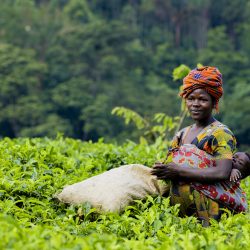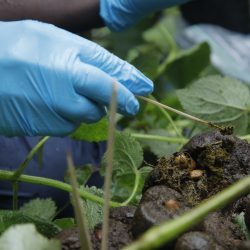Mountain gorilla ambassadors: Tracking the Kwitonda group
Blog | 11/05/11
This post was written by IGCP Director, Eugene Rutagarama, pictured left with Théogène Kayitankore, after he joins trackers in Volcanoes National Park to track and check-in on the mountain gorillas in the Kwitonda family group.
In my position of programme director whose time is mostly spent in the office handling bureaucratic issues, I enjoyed the following moments with the trackers and gorillas of the Kwitonda group. This group is symbolic to me. It was formed and habituated (slowly made accustomed to contact from people) in the Democratic Republic of Congo. The group subsequently moved to Rwanda in 2003 at the same time that tripartite discussions were happening that led to the tripartite agreement among the three countries- the Democratic Republic of Congo, Uganda and Rwanda. I call Kwitonda group our ambassadors as the group didn’t wait the signature of the agreement in January 2004. The group anticipated and made our discussions much more meaningful! The tripartite agreement laid down principles of collaboration among the three countries to collaboratively protect the mountain gorilla population.
Joining the Tracking Team
‘Tracker’ in mountain gorilla jargon means a person who goes early mornings to locate gorillas in order to make the life easy for gorilla tourists. Until the 90s, tourists themselves had to go together with guides to track and locate gorillas, taking hours before finding them. Sometimes, they would even simply miss them before going back out of the park disappointed. Those days were before the use of radios, GPS and mobile phones. Currently, for each group of gorilla visited, a team of two to three trackers enter the forest early morning, locate gorillas and communicate the location to the guide of the day who directs tourists to the group without any hesitation. As simple as that!
But the work of trackers is much more complex and incredibly valuable in the continued monitoring of the critically endangered mountain gorilla. Today on May 9, 2011, I joined the trackers’ team of Kwitonda group formed by Jerome Ndabereye and Théogène Kayitankore. Kwitonda group is formed by 21 individuals including four silverbacks (adult males with silver hear on their back), two black-backs (young male without silver hear on the back), five adult females, two sub-adults, three juveniles and five infants.
Avoiding Buffalo
My day started quite early as I worked to meet Jérome and Théogène at 6:00 am. The morning looked dark as a heavy fog was covering all summits of the volcanoes of the Volcanoes National Park. It has rained the previous night and the road was slippery. We rode with caution until we park the vehicle at two km from the edge of the park. Farmers, mostly women were already busy digging their lands, some harvesting Irish potatoes while others were preparing the soil for the new seeding season. Looking back when we reached the edge of the park, it was amazing to see how beautiful are the hills forming the chain of Buhoma and Buberuka, two regions of the former Ruhengeri province. One would think of a drawing done by a very reputable architect as lines between hills were in perfect harmony.
Anyway, the day was for tracking gorillas, not for poetry! Before we climbed over the stone wall separating the park from farmers land, we noticed fresh buffalo’s tracks. This meant they had been eating farmer’s crops during the night. Only three minutes after we entered the park, a group of seven buffalo ran away from us, moving eastward of the park. We concluded immediately that gorillas were either in the north or the west of this point as buffalos wouldn’t run towards gorillas; they fear them. With such useful information, we moved northward. Keeping relatively close, we walked in different but parallel directions focusing on potential gorilla tracks. On the way, Jérome heard a buffalo noise in front of us; we changed our direction and moved westward, until we reached where Jerome has left Kwitonda group yesterday afternoon. From that point, it became easy to follow tracks until we found gorillas’ nests only 500 meters from that point. We had then spent 40 minutes since we had entered the park. The second phase of our exercise started, counting gorilla nests.
Gorilla Nest Investigations
One of the key tasks of trackers when they reach a gorilla nest area is to count the number of gorilla having spent the night in these nests while also checking if they may experience some problems such as having a diarrhea or seeing blood from a wounded one. Counting gorilla from nests involves some experience as the number of nests is usually lower than the number of gorillas. The Kwitonda group we tracked today is formed by 21 individuals, but we saw only 15 nests. The easiest thing is to locate the nests of silverbacks because of the big size of their feces. Kwitonda having four silverbacks (Kwitonda, Akarevuro, Kigoma and Magumu), we found their nests at the peripheral side of other individual nests forming a kind of circle around other gorilla’s nests. Obviously silverbacks position their nests with the intention to protect the rest of the group in case of any threat. As young gorillas don’t build their own nests but stay besides their mothers or the dominant silverback, we were still able to identify where each gorilla had spent the night. We noticed that the feces of some individuals were showing some diarrhea, but this is normal when they eat bamboo shoots most of the day. Reassured, we walked away to start the third phase, the physical check up of each individual of the group.
Locating Each Gorilla and Observing Group Hierarchy and Rivalry
Following gorilla tracks, we found the group easily a hundred meters away from the nests. It was scattered into small subgroups, 12 gorillas around the dominant silverback, and five gorillas with the silverback named Kigoma and other individuals between the two subgroups. There was a distance of 600 meters between the two silverbacks. I learned from my fellow trackers that the opposite scenario is more frequent with more females around the silverback Kigoma and few around the dominant silverback Kwitonda. The later is getting old and weak and females gather around the silverback that can provide them more protection. The silverback Kigoma has already taken advantage of this situation by mating with the young female Okapi. He will likely take over the leadership of the group when the dominant Kwitonda will be too old, but for now, the age hierarchy is still working well as we will see him grooming the boss Kwitonda during the day.
Reaching the group, Jerome informed the guide of our location and we started checking on individuals. We first saw the black-back Marambo hanging in a tree and eating lianas. We had to use binoculars to watch him; he was healthy. The next was the young silverback of 12 years, Magumu. He was eating quietly when he saw us. Without waiting us to take note, he came straight to play with us. We moved back and we walked away. We decided to be more strategic in our approach. We had to locate first the dominant silverback Kwitonda as we knew that he will give the direction when he will move. We checked on him and waited to see him moving from where he was sitting. Besides him was the female Kibyeyi, mother of the silverback Akarevuro and four other females. My fellow trackers call Kibyeyi the favorite wife of Kwitonda as she is always moving close to him. Then we waited until Kwitonda moved southward. All individuals in his subgroup followed him in queue. We were able to check on each of them, 12 of them in few minutes. We went to do the same with Kigoma and Akarevuro. We were about to conclude our session when the guide reached our place with tourists. Until then we had not seen yet three gorillas. We had to stop and let tourists visit the group. Visitors enjoyed a good time with gorillas. At one time, the dominant silverback spent 30 minutes lying down and more than 10 gorillas came to groom him. Looking into the eyes of tourists, I could watch how many of the men were somehow envious of the dominant Kwitonda!
It is during this hour of tourist visit that we located the three remaining gorillas that we checked up and concluded our identification session. After the departure of tourists, we remained within the group. One incident occurred when the adult female Nyiramurema was attacked by the other adult female Kibyeyi to chase her from eating a delicious liana. But the dominant Kwitonda intervened and calmed Kibyeyi. This kind of minor attack is common within a gorilla group. Gorillas attack each other for food. But between Nyiramurema and Kibyeyi, there is a long story. Nyiramurema is a female that has lost a hand because of a snare. She has also lost an eye due to the female Kibyeyi. That day of bad luck for Nyiramurema in 2007, as it happens time to time, she seduced the non dominant silverback Akarevuro and got mate with him. Kibyeyi who happens to be the mother of Akarevuro was watching keenly the scene. After the mate, Kibyeyi attacked violently Nyiramurema until she removed one of her eye.
This kind of violent attack doesn’t occur often though within a gorilla group. And when it happens, the whole group bears some responsibilities. Because of this double handicap of Nyiramurema, other gorillas, female and black-back helped to grow her young baby Umoja who had only one year when she lost the eye. During the walk, they would carry Umoja on their back until he became independent to move and feed by himself. Umoja is now 5 years old and he is in a very good condition. Today until the time we left the group, everything went smoothly.
Coming Full Circle
Being with gorillas and working with trackers has something to do with my personal engagement. Having done the tracker’s work at the beginning of my gorilla conservation career in 1990, and being able to again work with fellow trackers and the gorillas in their wild haven, recharges my batteries and keeps up my sense of purpose- the commitment work alongside colleagues in not only Rwanda, but DRC and Uganda to conserve mountain gorillas.




